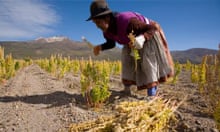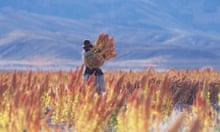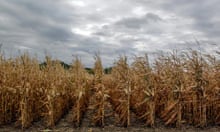Perhaps it is a small world, after all. At least it is in my kitchen today, because I'm rustling around, mining the cupboards for bags of bulgur, couscous and quinoa. They may be seemingly insignificant granular particles, but their punch can be mighty, as they're perfectly formed for delivering hefty whacks of flavour, which they steal greedily from herbs, garlic and spices in salads, stir-fries and soups. You could think of them as the original, ancient building blocks of molecular gastronomy. At least you could if you didn't mind annoying Heston a bit.
At this time of year it's easy to become a bit jaded. Roasted, mashed and puréed roots of all kinds have carried me deliciously through the winter, and though familiarity hasn't bred contempt exactly, I'm longing for something more, something different. I look out of the window and it seems like an interminable wait for fat, peppery radishes, juicy lettuces and sweet broad beans.
So I'm forced to look elsewhere for variety. Couscous, which is really a fine, granular form of pasta, can be tricky to get right – it takes seconds to transform from perfectly tender, fluffy grains to claggy mush. It's important not to soak it too long, so follow the instructions on the packet – as soon as it's had the required soaking time, add a dash of oil and toss the grains lightly with a pair of forks to loosen and separate.
It comes in various sizes and I find the larger-grained couscous is more forgiving to prepare, and nicer to eat – it's a touch more toothsome. Look out for barley couscous, too, which has a slightly more nutty flavour.
Bulgur, which is less processed than couscous, is made from cracked wheat and is great in salads, pilafs, tabboulehs and stuffings; it also adds tasty body to soups (see today's recipe). Quinoa is the seeds of a quite unrelated plant, but cooks up to a similar granular texture, and if you can't eat wheat, it's a great alternative to couscous and bulgur. Actually, that is one of the most appealing things about today's little belters – you can pretty much use them interchangeably, depending on your mood and what's in the cupboard.
In fact, all of today's recipes invite you to make them your own. Play with the seasonings – bump up the chilli in the quinoa stir-fry; swap the parsley for coriander and the dill for mint in the couscous; add cumin to the flavoured oil for the soup. Add some roasted onions to the squash and/or throw in some crumbled goat's cheese. Toss a small handful of toasted sesame seeds or a splash of toasted sesame oil in with the kale. Use your herbs and spices like a big Crayola box to banish the winter blahs with punchy, colourful flavours. Think small, taste big.
Turkish bulgur and red lentil soup
A substantial soup, great as a meal in itself with a hunk of bread and perhaps a salad of dressed greens. Serves three to four.
For the soup
100g red lentils
2 tbsp olive oil
1 large onion, peeled and finely chopped
1 tsp fresh thyme leaves
Salt and freshly ground black pepper
3 garlic cloves, peeled and minced
1 tbsp tomato purée
1 litre vegetable stock
50g bulgur wheat
1½ tsp sweet smoked paprika
1-2 tbsp thick yoghurt
For the flavoured oil
3 tbsp olive oil
20g butter
1 tsp dried mint
½ tsp sweet smoked paprika
Pick over the lentils, tip into a sieve and rinse well. Warm the olive oil in a large saucepan over a medium-low heat and sauté the onion with the thyme and a good pinch of salt until softened and just beginning to turn golden. Add the garlic and sauté for another minute. Add the tomato purée, stir, then tip in the stock, bulgur, lentils and paprika. Stir and bring to a boil. Reduce to a simmer, cover and cook for 15-20 minutes, until the lentils and bulgur are very soft. Purée in a food processor or with a stick blender if you prefer a smooth and creamy soup, or leave it as it is, adding a little more stock or water if it's too thick. Season to taste.
While the soup is cooking make the flavoured oil. Warm the olive oil in a pan with the butter until the butter has melted and the foaming subsides. Remove from heat and stir in the dried mint and paprika.
Serve the soup in warmed bowls with yoghurt and the flavoured oil trickled over the top, and sprinkled with a pinch or two of dried mint.
Quinoa stir-fry with kale chilli and nuts
This makes a tasty, quick meal when hot, but it's also good packed into a container and eaten cold at lunchtime. Serves two.
100g almonds or cashews
200g quinoa
5 tbsp olive oil
2 onions, peeled, halved and finely sliced
3 garlic cloves, peeled, halved and finely sliced
1 small red chilli, seeds and membrane removed, finely sliced
2.5cm piece fresh ginger, peeled and finely sliced
140g kale (or chard), shredded
150ml vegetable stock
Juice and zest of 1 lemon
Salt and freshly ground black pepper
Soy sauce, optional
Heat the oven to 180C/350F/gas mark 4. Place the almonds or cashews on a baking sheet and bake until slightly golden and fragrant, stirring once, about six to eight minutes. Leave to cool and chop very roughly.
Cook the quinoa according to the instructions on the packet. While it's cooking, warm three tablespoons of the oil in a large frying pan over a medium heat, then add the onions and fry until softened and beginning to turn golden. Add the garlic, chilli and ginger, and sauté for a couple of minutes. Throw in the kale and stir-fry for a couple of minutes. Add the stock and simmer until the kale is tender and most of the liquid has evaporated. Add the quinoa, remaining oil, lemon zest and juice, and stir to combine. Finally add the nuts, season to taste and serve hot or cold, with a splash of soy sauce, if you like.
Couscous with squash, sultanas and pumpkin seeds
Large-grain Palestinian couscous, or maftoul, is easier to cook than ordinary couscous (as in it's less likely to go mushy) and carries very well the flavours of everything you put with it. If you like, add some soft goat's cheese to the mix, too. Serves four.
70g sultanas
60g pumpkin seeds
1 medium-sized squash (about 750g)
3-4 tbsp olive oil
1 tsp ground cumin
Flaky sea salt and freshly ground black pepper
200g large-grain couscous
Water or vegetable stock
1 handful picked flat-leafed parsley, finely chopped
3 tbsp finely chopped dill
1 tbsp apple balsamic vinegar or cider vinegar
Put the sultanas in a bowl, pour over hot water or hot tea and leave them to plump up a bit. Warm a frying pan over a medium heat and toast the pumpkin seeds, rattling the pan from time to time, until fragrant and toasted. Tip into a bowl and set aside.
Heat the oven to 190C/375F/gas mark 5. Peel the squash, halve it and remove the seeds and fibres. Cut it into largish chunks of about 3cm and place in a roasting tin. Toss in two tablespoons of the olive oil, sprinkle on the cumin, salt and pepper, and toss again. Roast for 30-35 minutes, rattling the tin halfway through, until soft in the middle and gently charred around the edges.
Cook the couscous in water or stock according to the instructions on the packet.
To assemble the salad, toss the drained sultanas, pumpkin seeds and herbs with the couscous until well combined. Trickle over the remaining tablespoon or two of olive oil and the vinegar, and toss again. Taste, adjust the seasoning as necessary, and when you've achieved the balance of flavour you like, toss gently with the squash. Serve hot or cold.







Comments (…)
Sign in or create your Guardian account to join the discussion